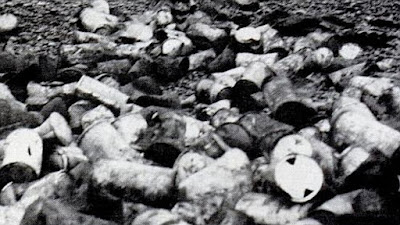Back at the start of this year - which seems a lifetime ago given recent and ongoing events - I took a trip a few kilometres north to view a rare batch of brewing records from a defunct Irish brewery - Robert Perry & Son of Rathdowney in Laois. The records are held in the local studies department of the Portlaoise library and are viewable by appointment only, so after a couple of exchanged emails I presented myself at their door and was ushered in to a book-packed room and a table full of cardboard boxes. The total of what I've found there must wait for another longer piece of writing and will entail some return visits, as I only rifled through some of the boxes held there and each contains a wealth of information. Although some of it relates to the non-brewing part of the business such as financial correspondence, leases and other topics, it will require time and dedication to sort through it all in detail - and it may require a wiser and more patient mind than mine!
The idea of brewing a Perry's beer has always appealed to me, indeed a couple of years back I brewed a double stout from these records thanks to a recipe published in Ron Pattinson's 'Let's Brew!' book. So, as my information-greedy eyes scanned over the recipes in the brewing books in the collection I decided it might be time to brew a little more from their records. Perry's are relatively well known in brewing history circles in Ireland but they deserve even more attention, especially for the range of beers they produced. Their line-up over the years included Special Stout, XX Stout, X Ale, XX Ale, Porter, 'ND' Pale Ale, Pale Ale, Pale Dinner Ale, XXXX Strong Ale, Vintage Ale, IPA and probably more, including brewing the famous Phoenix ale at one stage towards the end of the brewery's life in the sixties when it was part of a bigger conglomerate.
At this point it is well worth mentioning that I am not a great brewer and currently brew on an old Brew-in-a-Bag system, which is just about adequate as a kit. Regardless, I decided to plough on with my attempts to recreate a historical brew, so after copying various recipes from the books into PDFs I sent some off to Edd Mather and Ron Pattinson who both specialise in this sort of thing. I was particularly interested in an early X ale or Mild, as this is a style I like and one that was a little rare in Ireland - although more common than many had thought, which you will be aware of if you have read some of my other posts.
One from 1934 caught my eye...
One from 1934 caught my eye...
Edd put a recipe up on his blog and Ron duly obliged me by sending back a relatively simple homebrew version that I could adapt for my kit.
And so, off I went and brewed an Irish Mild which ended up an amalgam of both recipes...
It should be noted that if you look closely at the entry for the beer in the image from the brewery book above you will see that it says 'Unsatisfactory brew. Ale very dull when racked.' but undeterred I pressed on with the experiment. I took a few liberties with the recipe, such as using Crisp's Chevallier Malt, which was probably not what Perry's would have used, and also by fermenting with a dried English ale yeast, but I tried as much as possible to stick to the recipe as far as percentages and timings were concerned. The alcohol content wasn't quite right but ended up at an acceptable - to me - 3.5% with 30 IBUs according to the software I used. I racked it into proper pint bottles, which it wasn't put into at the time I'd imagine(?), and left it to condition.
So how did it taste? Well very pleasant if I do say so myself! The above photo in a 1939 pint glass (the closest I had to the brewing year) was taken when it wasn't completely conditioned but it has since dropped clear in the bottles and is a wonderful golden colour. It's mostly biscuit - Rich Tea with Malted Milk and a dash of Ginger Nut with a pleasantly odd, light floral bitterness. At the time of writing the carbonation is nearly there, I think it needs another week or two, although the head retention is quite poor.
Certainly far from 'Unsatisfactory'!
Is it the same as the original brew? I'm pretty sure it isn't but that's not the point, the point is that I rebrewed it, drank it, and posted here and elsewhere about it.
As I've said before, we need to remember that once upon a time, and not too long ago, Ireland brewed more than just stouts and red ales...
Liam
With thanks to Edd, Ron and the nice people in the local studies department of Portlaoise library.
(I might add that any errors and mistakes are mine and nothing to do with the recipes.)






